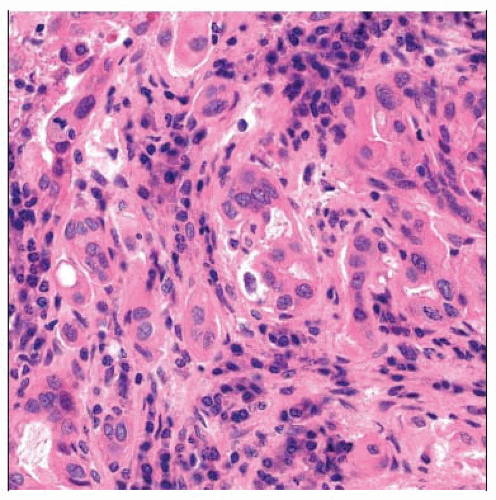Intrahepatic Cholangiocarcinoma
Matthew M. Yeh, MD, PhD
Key Facts
Clinical Issues
Incidence has been increasing around world, including USA
Very prevalent in Asia, particularly in northeastern Thailand
Well-known risk factors include liver fluke infection, primary sclerosing cholangitis, hepatolithiasis, Thorotrast exposure, congenital anomalies of bile ducts
Serum level of CA19-9 is commonly elevated
Most patients are diagnosed with advanced stages of disease
Dismal prognosis
Macroscopic Features
Can be peripheral or hilar (Klatskin tumor)
Microscopic Pathology
Well to moderately differentiated adenocarcinoma
Desmoplastic stroma
Frequently shows perineural invasion
Mucin typically present
CK19, CK7 positive
Neoplastic cells can form glands, solid nests, cords, or papillary structures
Top Differential Diagnoses
Hepatocellular carcinoma
Metastatic adenocarcinoma
Epithelioid hemangioendothelioma
Bile ductular reaction or atypical biliary epithelium due to inflammation
Benign hamartoma
 Intrahepatic cholangiocarcinomas generally arise in noncirrhotic livers. This gross photograph shows a white-tan, firm, and distinct mass in a background of noncirrhotic liver. |
TERMINOLOGY
Definitions
Malignant adenocarcinoma arising from bile duct epithelium within liver
ETIOLOGY/PATHOGENESIS
Multistep Carcinogenesis
Chronic inflammation may be common pathogenic pathway
CLINICAL ISSUES
Epidemiology
Age
Average age at presentation is 60 years old
Gender
Equal frequency in men and women
Ethnicity
Very prevalent in Asia, particularly in northeastern Thailand (associated with liver fluke infestation)
Presentation
10-20% of primary liver malignancies
Incidence and mortality rates have been increasing in several regions around world
Incidence has also increased 3x in past few decades in USA
Most patients are diagnosed with advanced stages of disease
Symptoms
Abdominal pain
Weight loss
Malaise
Jaundice
Laboratory Tests
Serum level of CA19-9 is currently most important tumor marker
Alkaline phosphatase and bilirubin variably elevated
Prognosis
Long-term survival is dismal
Risk Factors
Liver fluke infection
Clonorchis sinensis
Opisthorchis viverrini
Primary sclerosing cholangitis
Hepatolithiasis
Thorotrast exposure (radiographic contrast medium widely used from 1930-1955)
Congenital anomalies of bile ducts
Choledochal cysts
Hepatitis B and C infection, alcohol use, and cirrhosis have recently been suggested as potential risk factors
Stay updated, free articles. Join our Telegram channel

Full access? Get Clinical Tree



